ITS3 and FoCal: Two new subdetectors to extend ALICE’s physics reach

The ALICE experiment at the Large Hadron Collider (LHC) is dedicated to studying heavy ion collisions, which recreate the hottest and densest matter ever observed in a lab – the quark-gluon plasma (QGP). By studying this exotic state of matter, scientists aim to understand the strong interaction, responsible for keeping the quarks and gluons together in hadrons, and protons and neutrons in atomic nuclei. The strong interaction is described by quantum chromodynamics (QCD), one of the pillars of the Standard Model The physics program of ALICE has broadened over the years to cover many more aspects of the strong interaction, as demonstrated in the recent review “A journey through QCD”. Among others, an exciting direction is the study of the high gluon densities in large nuclei, where a new saturation regime may be reached.
The ALICE detector has undergone a major upgrade during the LHC long shutdown 2 (2019-2021), which largely enhanced its performance, especially the track reconstruction precision and high interaction-rate capabilities. Two new upgrades are in preparation for the next long shutdown 3, scheduled from 2026-2028, with the goal of further enhancing the physics reach of the experiment: a new inner barrel for the Inner Tracking System (ITS3) and a forward calorimeter (FoCal) optimized for photon detection in the forward region. Figure 1 shows the locations of ITS3 and FoCal in the ALICE setup.
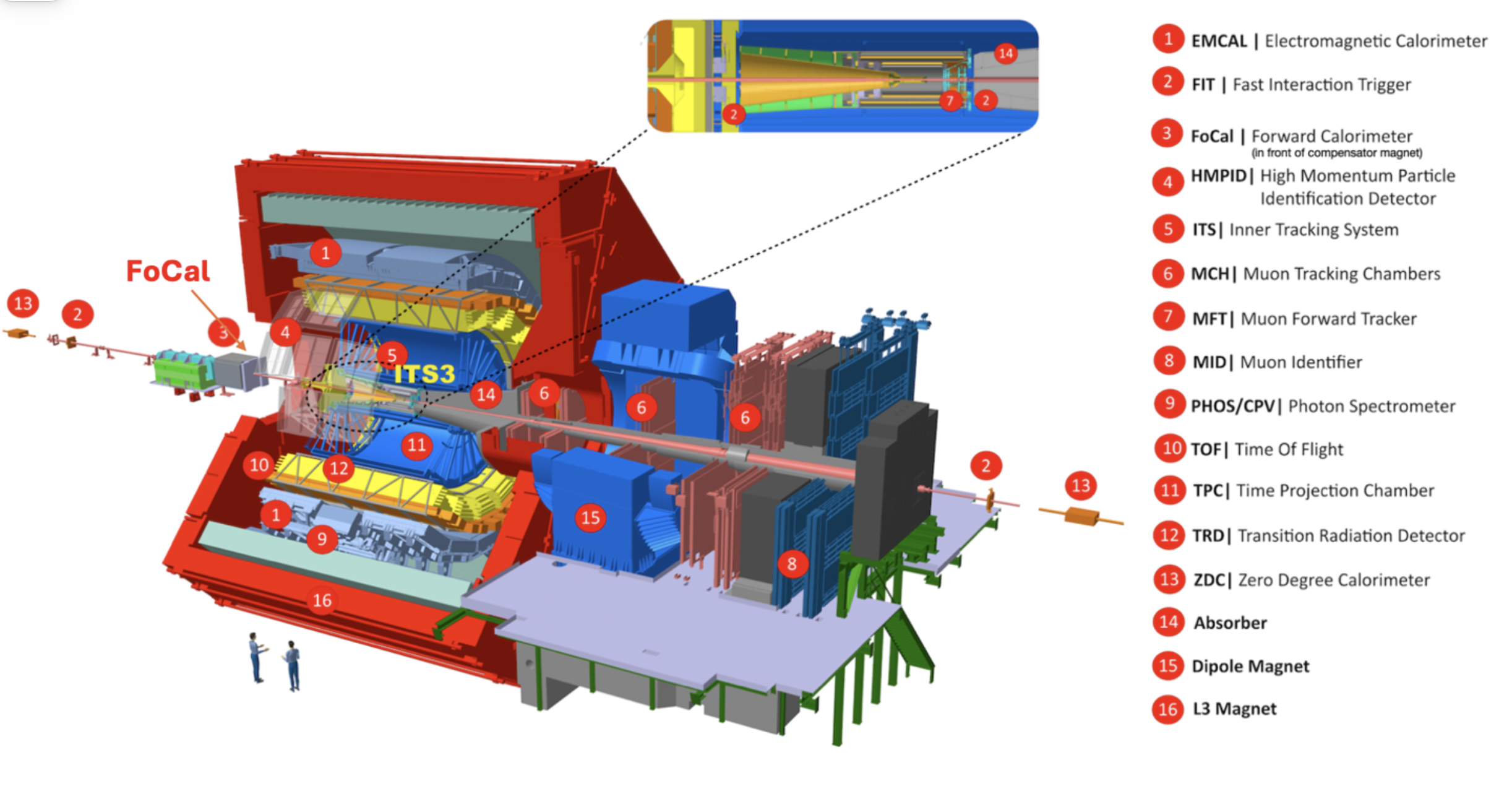
Figure 1: ALICE detector configuration for Run 4. ITS3 is close to the interaction point, whereas FoCal is located in front of the compensator magnet and outside the magnet doors on the A-side, opposite the muon arm.
Both upgrade projects have reached the important milestone of completing their Technical Design Reports, which were endorsed by the CERN review committees in March 2024. The construction phase of ITS3 and FoCal starts now, with installation in early 2028, to be ready for data taking in 2029.
Inner Tracking System 3: Sharper Than Ever
ALICE’s current Inner Tracking System, installed for the ongoing LHC run, is already an impressive feat of engineering. With 10m2 of active silicon area and nearly 13 billion pixels, this is the largest pixel detector ever built. The current ITS uses monolithic active pixel sensors (MAPS) which integrate the particle-detecting sensors in the same silicon device as the readout electronics placed on carbon fiber support structures with integrated water cooling. The ALPIDE chip contains more than half a million pixels in an area of 15 × 30 mm2 and features an impressive resolution of about 5 μm in both directions – the secret to the outstanding performances. The new ITS3 builds upon this success and takes things to a whole new level.
The new ITS3 takes this concept to the extreme by further reducing the material placed in the particle’s trajectory and eliminating the water-cooling pipes. The material budget gets reduced from the present 0.36% X0 per layer to about 0.07% X0 per layer. To improve the proximity to the interaction point (IP), the first layer of the ITS3 is placed much closer to the IP at 19 mm, only 2 mm from the beam pipe. Overall, the new system will boost the pointing resolution of the tracks by a factor of two compared to the present ITS detector, strongly enhancing measurements of thermal radiation emitted by the QGP and enabling insights into the interactions of charm and beauty quarks as they propagate through it.
The ITS3 sensors are 50 µm thick and as large as 26×10 cm2. These sensors can now be bent around the beampipe in a truly cylindrical shape. They are supported by carbon fiber foam only without the need for stiff structures and cooled by airflow instead of water. The electrical connections to supply power, control, and readout of the sensor are done via the stitching technology. This technology connects otherwise independent sensor regions (reticles) with metal lines integrated into the sensor, avoiding external cabling and, thus, material in the detector.
Figure 2 shows a wafer that uses stitching on a 30 cm wafer. The ALICE ITS3 upgrade for Run 4 will feature six half-layer sensors 26 cm long in the 𝑧 direction, two in each layer, that will be thinned to about 50 𝜇m. Each sensor will consist of 3-5 wafer-scale stitched MAPS. Figure 3 shows the detector's components. The sensors will be mechanically held in place by carbon foam. The structure is shown in Figure 4.
The ITS3 will strongly enhance the ALICE physics reach in Run 4 for measurements of thermal radiation emitted by the quark-gluon plasma in the form of electron-positron pairs (virtual photons) and for measurements of heavy-flavour mesons and baryons that provide insight into the interaction of charm and beauty quarks when they traverse the plasma.
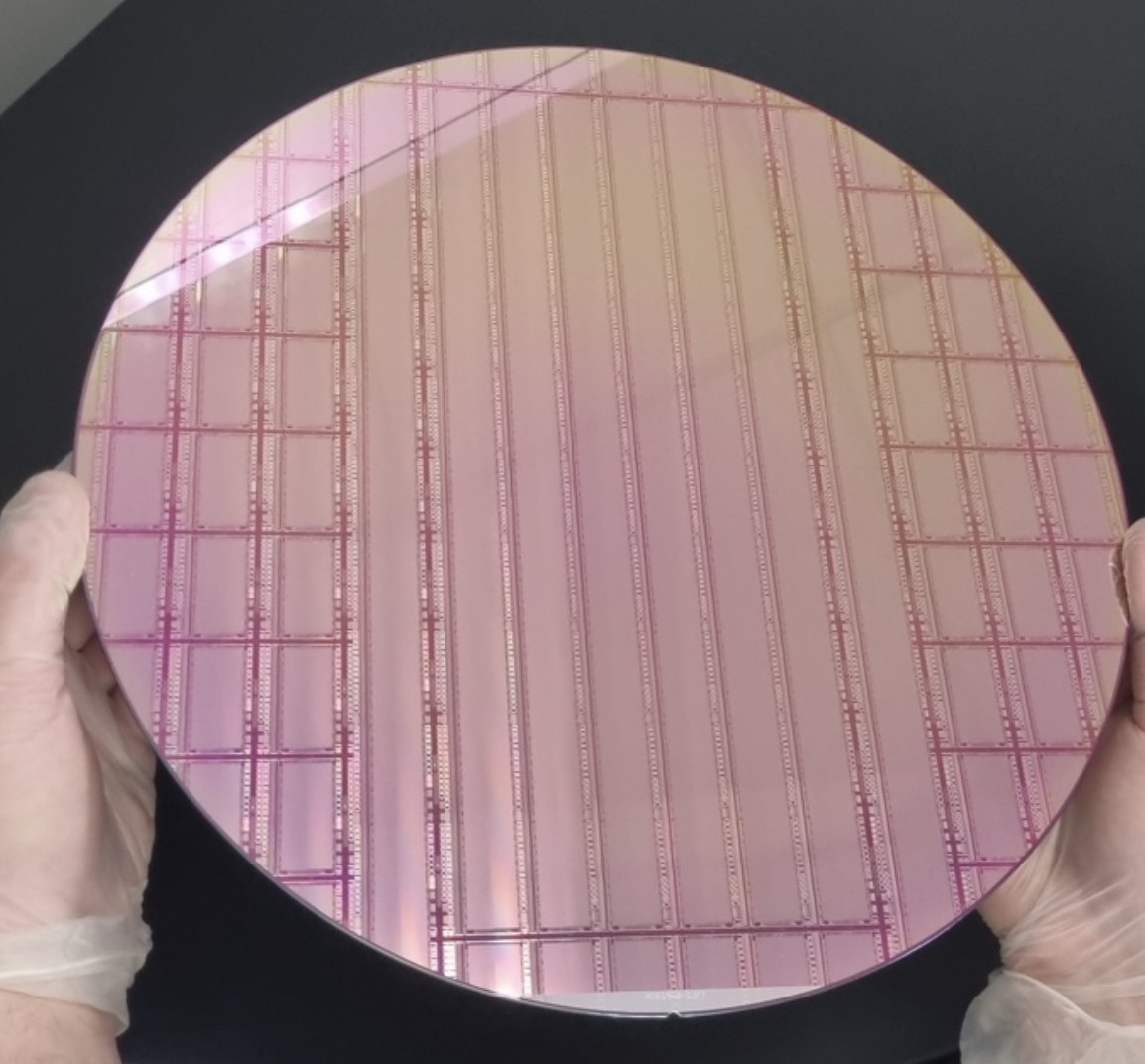
Figure 2: A 30 cm wafer of the ITS3 using stitching (middle lanes) from engineering run 1.

Figure 3: Components of ITS3 engineering model.
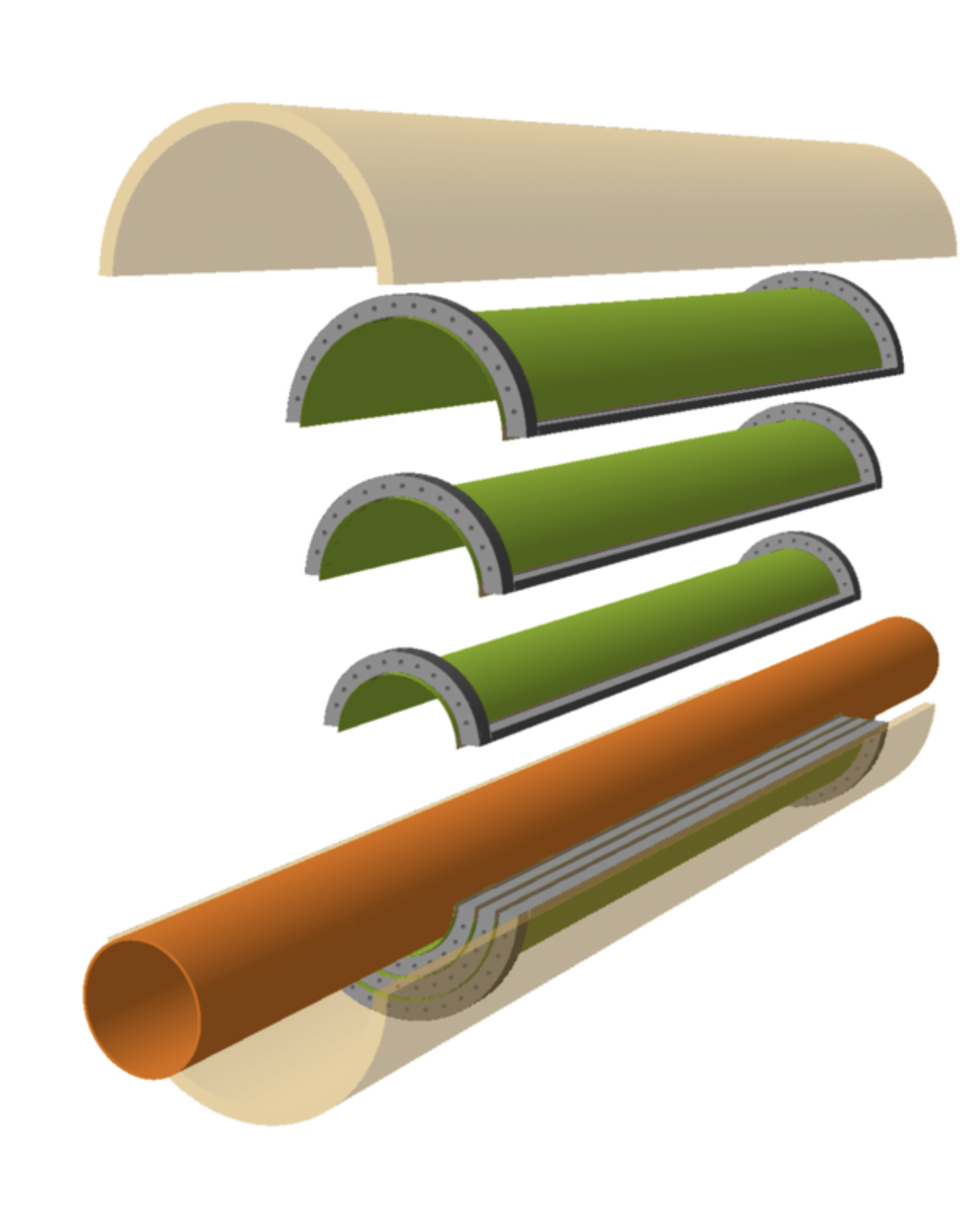
Figure 4: ITS3 layout with 3 half-layer sensors (green) held in place by carbon foam (gray) and surrounded by a cylindrical support structure (beige). The beam pipe (orange) has a 16 mm radius to allow the first layer to be placed at 19 mm from the interaction point.
The secret behind ITS3's success lies in its cutting-edge sensor technology. Here are some key features:
- Ultra-Thin Sensors: At 50 micrometers thick, these sensors are incredibly thin, allowing for a highly detailed picture of particle interactions.
- Large Sensor Size: Measuring up to 26×10 cm², these sensors provide a wider field of view.
- Stitching Technology: This innovative technique allows scientists to connect individual sensors into a large, continuous structure.
- Cylindrical Design: The sensors can be bent to form a true cylinder around the beam pipe, maximizing detection efficiency.
- Air-Cooled Technology: A first for the inner layers, air cooling replaces water cooling, reducing weight and minimizing the impact on particle trajectories.
FoCal: A Technological Marvel
The new Forward Calorimeter (FoCal) is optimised for photon detection in the forward direction. This innovative detector will be positioned strategically to study a previously unexplored region in ALICE. FoCal will measure prompt and isolated photons, and identify neutral pions and other neutral mesons, J/ψ and its excited states, inclusive jets, and various correlations of these observables. FoCal will carry out long-range correlation measurements in conjunction with the central barrel detectors and the muon arm on the opposite side of ALICE. These measurements offer a unique possibility for a systematic exploration of QCD at small Bjorken-x. FoCal extends the scope of ALICE by adding new capabilities to explore the small-x parton structure of nucleons and nuclei.
FoCal is based on two main key components working in tandem. The first, the Electromagnetic Calorimeter (FoCal-E), will use alternating layers of silicon and tungsten to precisely measure the energy and profile of incoming particles. Crucially, it incorporates high-granularity pixel layers, allowing FoCal-E to differentiate between single photons and showers of decay photons produced by other particles. The second component, the Hadron Calorimeter (FoCal-H), utilizes copper and scintillating fibers to precisely measure the energy of hadrons, particles composed of quarks. This information from FoCal-H plays a vital role in distinguishing the coveted prompt photons from the background noise of other particles within the detector. FoCal will be located on the A-side of ALICE (positive direction along the z-axis or beam line in the ALICE coordinate system), exterior to the ALICE solenoid, and in front of the compensator magnet (Figure 1).
For FoCal-E, a small transverse shower size is necessary to optimize the photon shower separation and to minimize occupancy effects. Consequently, FoCal-E is a Si+W sampling calorimeter, which provides a compact electromagnetic calorimeter with a small effective Molière radius and fine lateral granularity readout. As absorber material, tungsten (W) is chosen because of its small Molière radius (RM = 0.9 cm) and radiation length (X0 = 3.5 mm).
As shown in Figure 5, FoCal-E has a hybrid design using two different Si readout technologies: (a) 18 silicon pad sensor layers with transverse cell size of 1 cm2, which are read out and digitized by the High Granularity Calorimeter ReadOut Chip for silicon pad sensors (HGCROC) chip developed by the CMS collaboration; and (b) two pixel layers positioned at the 5th and 10th layer, using the ALPIDE chip which has a pixel size of ≈ 30 × 30 μm2. Each layer consists of a W plate with a thickness of about 1X0 followed by the active silicon sensor-based structure. Longitudinal segmentation adds further capability for particle identification and background rejection. Channels in each layer are read out individually.
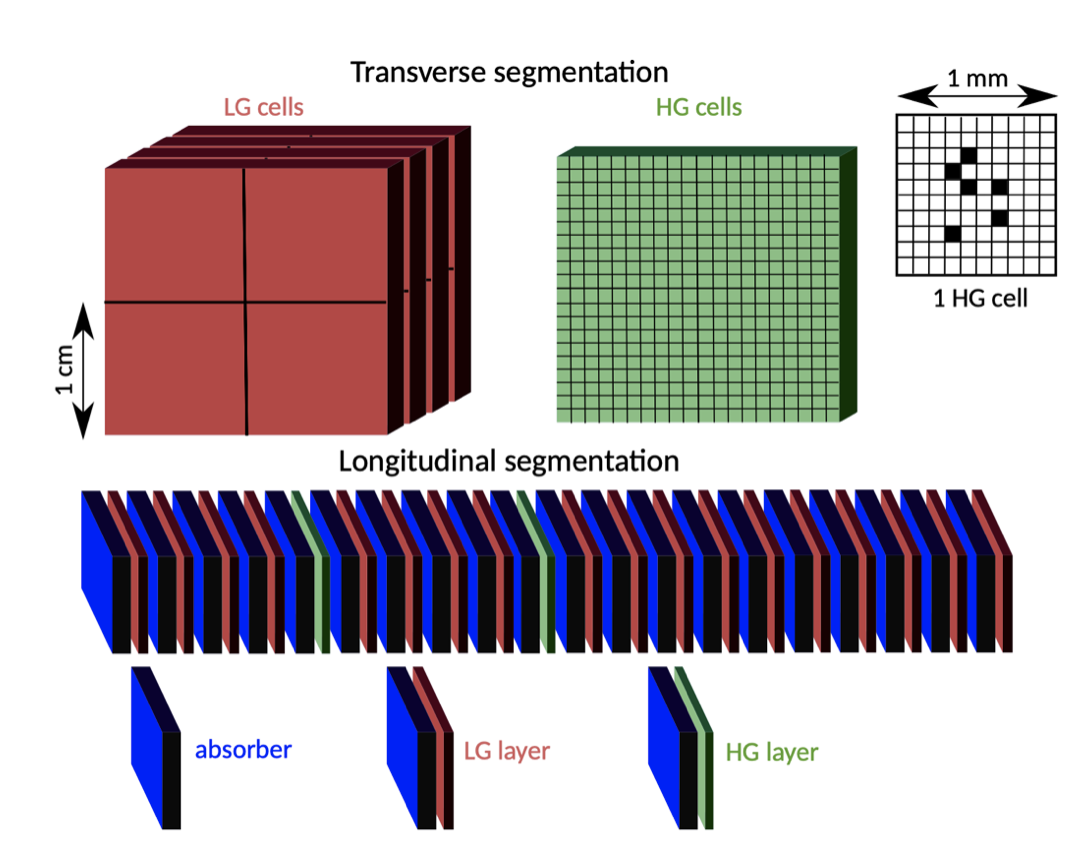
Figure 5: Sketch of FoCal-E, showing 20 layers of W (each 3.5 mm thick) and Si sensors. There are 18 layers consisting of pad sensors with 1 cm2 area (low granularity cells, denoted as LG) and two layers, at positions 5 and 10, consisting of pixel sensors with much finer granularity (high granularity cells, denoted as HG). Each layer can be read out individually.
FoCal-E is followed by a hadronic calorimeter (FoCal-H), whose primary functions are photon isolation and jet measurements. FoCal-H covers the same pseudorapidity range as FoCal-E, and is placed as close as possible to FoCal-E to minimize its size and minimize transverse expansion of showers initiated in FoCal-E. FoCal-H consists of conventional copper capillary tubes with outer diameter of 2.4mm and a length of 110cm filled with scintillating fibers, that are read out by SiPMs. FoCal-H has transverse but not longitudinal segmentation, in contrast to FoCal-E. A sketch of the FoCal-E and FoCal-H is shown in Figure 6.
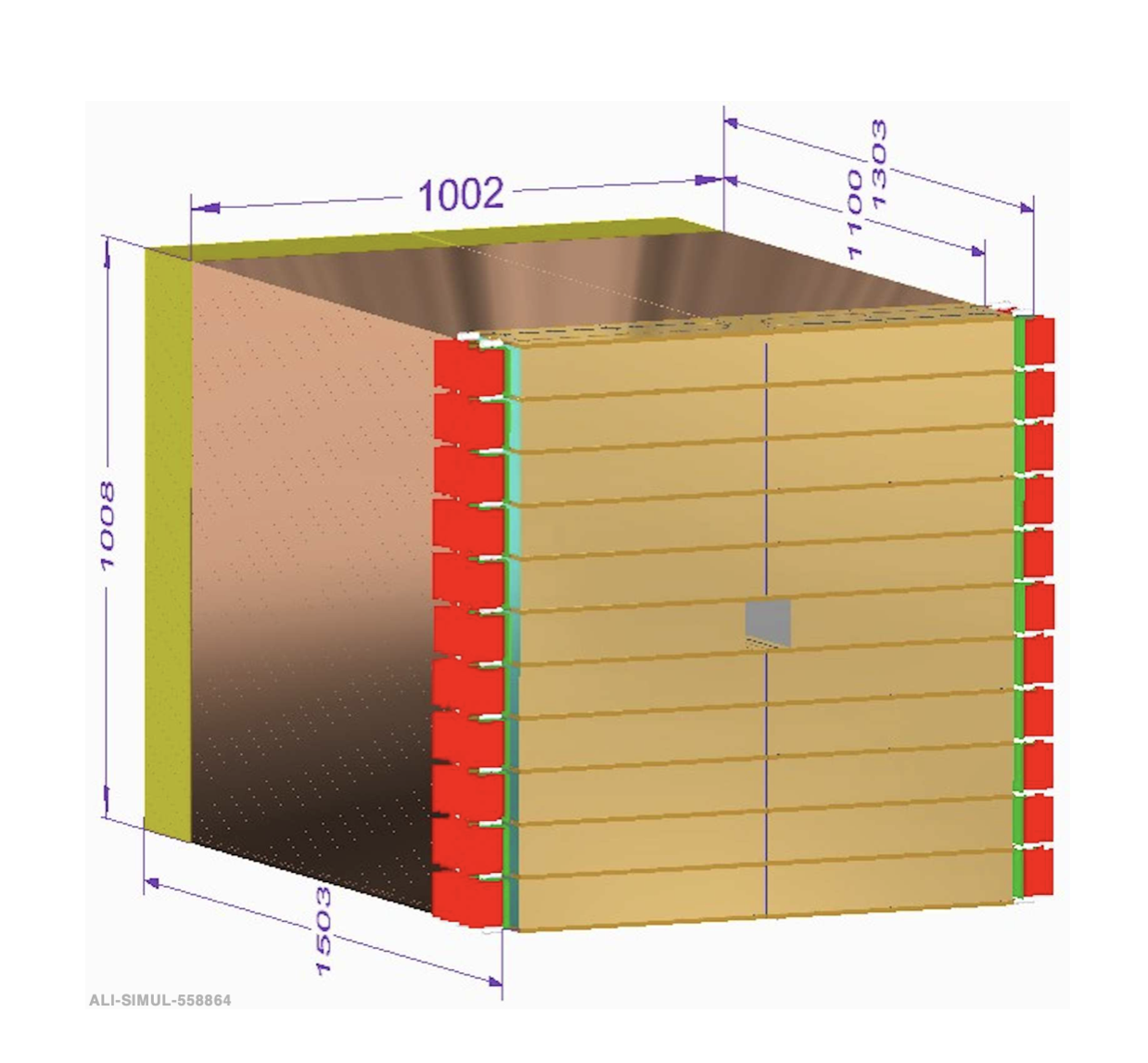
Figure 6: Sketch of FoCal-E and FoCal-H. The rectangular opening in the middle (84×84 mm2) accommodates the beam pipe. The horizontal space visible between the FoCal-E modules is due to the cooling plates. The readout for FoCal-E is on the detector sides, while for FoCal-H it is at the back of the detector. Dimensions are given in mm.
An extensive R&D program was carried out over the past decade, with several prototypes constructed and measurements carried out using test beams. Specifically for FoCal-E, various prototype systems of electromagnetic calorimeters were designed and tested. A photograph of the final prototype test is shown in Figure 7.

Figure 7: The final prototype of FoCal-E and FoCal-H tested at the SPS in the fall of 2022 and May of 2023.
A Brighter Future for Heavy Ion Physics with ALICE 3
The ITS3 and FoCal upgrades represent a significant leap forward for the ALICE experiment. With these powerful tools, ALICE will be better equipped to unlock the mysteries of the quark-gluon plasma, explore the structure of nuclei at a deeper level, and potentially uncover new phenomena within the realm of heavy ion physics.
Despite the expected progress, ALICE will still be missing several key measurements after the LHC Run 3 and 4. To address these, the ALICE collaboration has submitted a letter of intent to build the next-generation heavy-ion experiment, called ALICE 3, for LHC Run 5 and Run 6.
ALICE 3 is a compact, large-acceptance tracking and particle-identification detector with excellent pointing resolution as well as high readout rates. The tracking information will be provided by an all-silicon detector with an outer radius of 80 cm in a magnetic field provided by a superconducting solenoid, complemented by a dedicated vertex detector that can close in to a minimum radius of 5 mm after beam stabilisation. The tracker and vertexer will leverage on the CMOS Monolithic Active Pixel Sensor technology that is being developed for the ITS3. Particle identification will be provided by silicon time-of-flight detectors, a RICH detector with silicon sensors, an electromagnetic calorimeter and a muon identifier.
The coming years will see further development and testing of these exciting technologies, paving the way for groundbreaking discoveries in the years to come.
Acknowledgment: The authors would like to thank Andrea Dainese, Marco Van Leeuwen and Kai Schweda for their contributions and fruitful comments.
Further Reading
1. Technical Design Report of the ALICE Forward Calorimeter (FoCal)
